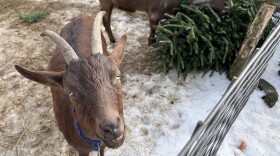For decades now, scientists and volunteers in the Northeast have been trying to bring back the American chestnut tree, which a century ago comprised about 25 percent of New England’s forests.
Blight nearly wiped out the American chestnut, and it did so quickly. Restoring the tree is taking a little more time, in part because the blight is still out there.
David Brooks, who writes the weekly Granite Geek science column for the Nashua Telegraph and GraniteGeek.org. says there are several efforts to get around that significant hurdle. The American Chestnut Foundation, he says, is “hybridizing American chestnuts with Chinese chestnut, which is a related tree that is not affected by the blight. But it doesn’t look at nice – it’s not the same species exactly.” The foundation, he says, finds the handful of trees that have managed to avoid the blight and “hand-pollinate them, and you cover each flower with a bag, so other kinds of pollen doesn’t get in and infect it.”
“You come back in the fall, take the bag off and harvest the nuts. And then you use those to grow a next generation, and then you do the same thing with them. What they’re trying to do is create a tree that looks like an American chestnut but has enough Chinese chestnut genes in it that it can be resistant.” Hybridizing takes time, Brooks says, so another research project in New York state is inserting genes from wheat that proponents hope will make the trees blight-resistant as well.
"Double-blind" protocols and diversity in the forest
There’s a project going on in Hollis right now to see which hybrid trees are holding up and which are having problems. Brooks notes that some of the trees at the test plot were planted several years ago. And now? “Some of them are 3-4 feet tall, and some of them are one foot tall and some of them are dead.” But the scientists studying at this test plot don’t know which tree is which, so as not to unconsciously influence their observations and reports. “It’s better to not know,” he says, “so you can’t do that by accident.”
The troubles with American chestnut trees is just one problem facing New Hampshire forests, according to Brooks. “An even better known one than the chestnut tree is the one that’s been going on for the American elm,” he says. “For a long, long time folks in Keene have been creating hybrids – again, cross-pollinating with resistant species to try to create an elm tree that won’t succumb to Dutch elm disease, which killed them all off back in the ‘30’s.
“Recently we have problems facing our ash trees, from the emerald ash borer; hemlock trees from the wooly adelgid; there’s the longhorned beetle that eats just about anything… you want to return some species if you can for forest diversity, because diversity is a good thing.”
The only trick is that we have to wait a few decades to see if the ideas were successful. “Everybody says that planting a tree is the ultimate sign of optimism, because you’ll never live to see it,” Brooks says. “There are many people working on this right now who will not be around to see whether it actually succeeds. Which is kind of cool.”







